Museum of the future: Social Virtual Reality to unlock shared cultural heritage experiences
At Sound & Vision, we believe in the power of cultural heritage to bring people together. With a renovation of our museum experience in full swing, we wondered what role Virtual Reality (VR) could play in creating shared experiences around digitised objects from our museum collection. In collaboration with the Centrum Wiskunde & Informatica (CWI) we have developed the innovative social VR application 'MediaScape Extended Reality (XR)'. During VR Days Europe this November we gave visitors a taste of a ‘museum visit of the future’.
At Sound & Vision, we believe in the power of cultural heritage to bring people together. With a renovation of our museum experience in full swing, we wondered what role Virtual Reality (VR) could play in creating shared experiences around digitised objects from our museum collection. In collaboration with the Centrum Wiskunde & Informatica (CWI) we have developed the innovative social VR application 'MediaScape Extended Reality (XR)'. During VR Days Europe this November we gave visitors a taste of a ‘museum visit of the future’.

While our physical museum is still undergoing a massive renovation (scheduled to open in late 2022), using MediaScape XR visitors can already indulge themselves in a virtual representation of the new museum. This application lets you walk freely through the media museum of Sound & Vision and lets you interact with a 3D recreation of a famous cultural artefact: the costume worn by Jerney Kaagman of Earth and Fire during her 1979 performance on the tv-show TopPop. In the virtual environment, visitors can even wear the costume and reenact the TopPop show together with other visitors.
Designing VR for cultural heritage
But why TopPop and the costume? This decision was made in close collaboration with Sound & Vision curators. We conducted focus group sessions and co-creative workshops to understand the motivations of both museum professionals and visitors, gather novel ideas and collect design requirements. The Earth and Fire outfit and the TopPop setting are considered part of the collective memory of The Netherlands. This provided the designers at CWI great opportunities for storytelling and creating a shared experience. Moreover, it allowed for immersive and fun experiences in VR, such as trying on the suit!
Our exploration of VR for visitor experiences also stems from a desire to do more with our digitised collections. Traditionally, efforts to digitise museum collections have focused primarily on creating digital surrogates. As we are rethinking and redesigning the layout of our physical museum, we are looking into innovative ways to build on our digitised museum collections to support greater interactivity and personalisation. Furthermore, for fragile physical objects, digitisation can help to increase accessibility and allow more people to engage. These developments illustrate an exciting shift in museum experiences from passive observation to more active exploration and engagement.

The power of Social VR
In our research we asked people about the ways they like to visit museums. While everyone has their preferences, what stood out for most is that museum visits are, in one way or another, a social experience. This provided important support for our bet on the social VR aspects of the MediaScape XR project.
The application is built on the VRTogether platform which allows connecting multiple users in the same virtual space. To create a virtual representation of users, it uses the open source CWI Point Clouds software suite. This framework enables capturing a person as a photorealistic set of points in virtual 3D space and can transmit this representation for rendering in a shared virtual space with multiple users in real time. These ‘point clouds’ can be transmitted via the internet, which enables users to experience each other’s presence in virtual space while being in separate locations physically.
MediaScape XR aims to immerse visitors in the environment and enable them to have a close-up interaction, with both the artefact and each other. This way MediaScape XR integrates elements from gamification, education and experience design in a novel way to engage with cultural heritage.

Demo time!
After several rounds of prototyping and user testing, it was time to share our results with a wider audience! The specific setup we used to showcase the system at VRDays consisted of two users. Each user was captured by three 3D sensors and was wearing an HTC VIVE PRO headset with controllers assisting them to navigate and interact in the virtual space.
VRDays provided a great environment to test the latest version of the MediaScape XR experience: around 150 visitors experienced and evaluated the final version of the application. Based on this latest test, benchmarked evaluations scored above average results and showed significant improvements compared to our previous evaluations. It’s exciting to see the impact of input gathered from domain experts and users as part of the user-centered design process!
While the demo at VRDays placed two users side by side, the setup supports fully remote participation: one user could be located in Hilversum while another other joins from London! And here, perhaps, lies the greatest strength of social VR. The ultimate goal of MediaScape XR is to provide new ways to interact with cultural heritage, accessible to a broader range of visitors beyond the walls of our museum. We hope that through these types of technologies, we can encourage everyone to visit museums together more frequently, regardless of their location or abilities!
